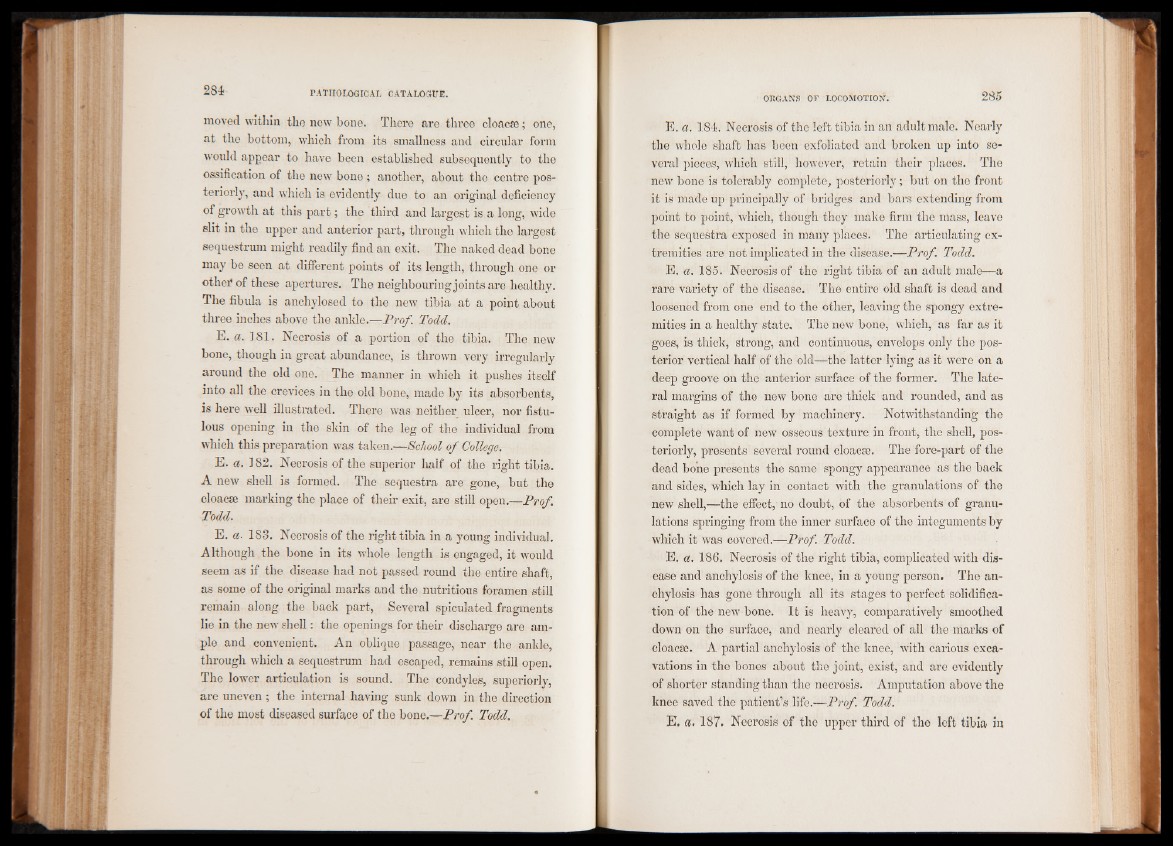
moved within the new bone. There are three cloacse; one,
at the bottom, which from its smallness and circular form
would appear to have been established subsequently to the
ossification of the new bone ; another, about the centre posteriori}'',
and which is evidently due to an original deficiency
of growth at this part; the third and largest is a long, wide
slit in the upper and anterior part, through which the largest
sequestrum might readily find an exit. The naked dead bone
may be seen at different points of its length, through one or
other* of these apertures. The neighbouring joints are healthy.
The fibula is anchylosed to the new tibia at a point about
three inches above the ankle.—Prof. Todd.
E. a. 181. Necrosis of a portion of the tibia. The new
bone, though in great abundance, is thrown very irregularly
around the old one. The manner in which it pushes itself
into all the crevices in the old bone, made by its absorbents,
is here well illustrated. There was neither ulcer, nor fistulous
opening in the skin of the leg of the individual from
which this preparation was taken.—School of College.-
E. a. 182. Necrosis of the superior half of the right tibia.
A new shell is formed. The sequestra are gone, but the
cloacse marking the place of their exit, are still open.—Prof
Todd.
E. a. 183. Necrosis of the right tibia in a young individual.
Although the bone in its whole length is engaged, it would
seem as if the disease had not passed round the entire shaft,
as some of the original marks and the nutritious foramen still
remain along the back part, Several spiculated fragments
lie in the new shell: the openings for their discharge are ample
and convenient. An oblique passage, near the ankle,
through which a sequestrum had escaped, remains still open.
The lower articulation is sound. The condyles, superiorly,
are uneven ; the internal having sunk down in the direction
of the most diseased surface of the bone.—Prof. Todd.
E. a. 184. Necrosis of the left tibia in an adult male. Nearly
the whole shaft has been exfoliated and broken up into several
pieces, which still, however, retain their places. The
new bone is tolerably complete, posteriorly; but on the front
it is made up principally of bridges and bars extending from
point to point, which, though they make firm the mass, leave
the sequestra exposed in many places. The articulating extremities
are not implicated in the disease.—Prof. Todd.
E. u. 185. Necrosis of the right tibia of an adult male—a
rare variety of the disease. •The entire old shaft is dead and
loosened from one end to the other, leaving the spongy extremities
in a healthy state. The new bone, which, as far as it
goes, is thick, strong, and continuous, envelops only the posterior
vertical half of the old—the latter lying as it were on a
deep groove on the anterior surface of the former. The lateral
margins of the new bone are thick and rounded, and as
straight as if formed by machinery. Notwithstanding the
complete want of new osseous texture in front, the shell, posteriorly,
presents several round cloacse. The fore-part of the
dead bone presents the same spongy appearance as the back
and sides, which lay in contact with the granulations of the
new shell,—the effect, no doubt, of the absorbents of granulations
springing from the inner surface of the integuments by
which it was covered.—Prof. Todd.
E. a. 186. Necrosis of the right tibia, complicated with disease
and anchylosis of the knee, in a young person. The anchylosis
has gone through all its stages to perfect solidification
of the new bone. It is heavy, comparatively smoothed
down on the surface, and nearly cleared of all the marks of
cloacse. A partial anchylosis of the knee, with carious excavations
in the bones about the joint, exist, and are evidently
of shorter standing than the necrosis. Amputation above the
knee saved the patient’s life.—Prof. Todd.
E. a. 187. Necrosis of the upper third of the left tibia in